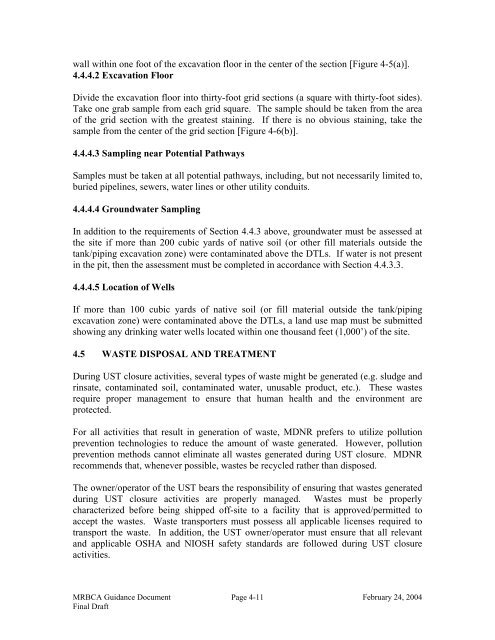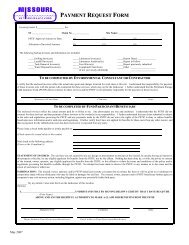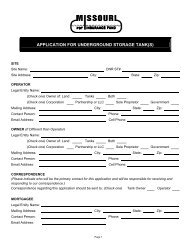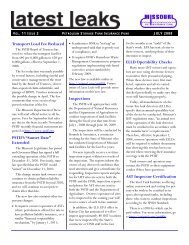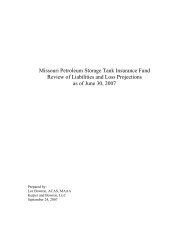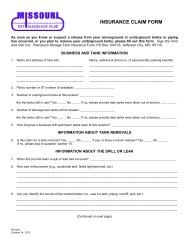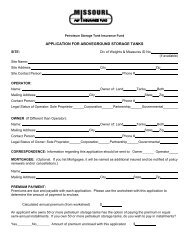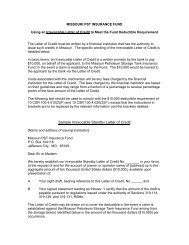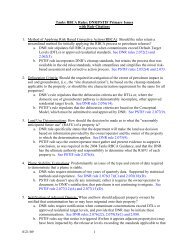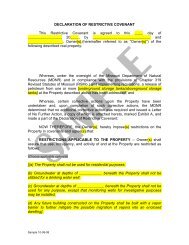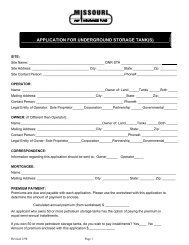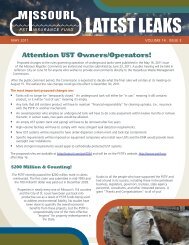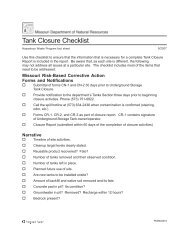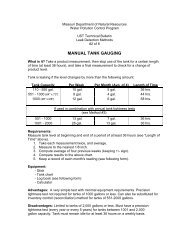- Page 1 and 2: Missouri Department of Natural Reso
- Page 3 and 4: FOREWORDThis guidance document desc
- Page 5 and 6: ABBREVIATIONSAPI American Petroleum
- Page 7 and 8: TABLE OF CONTENTSCOVER PAGEACKNOWLE
- Page 9 and 10: 5.0 SITE CHARACTERIZATION AND OTHER
- Page 11 and 12: 7.0 TIER 1 RISK ASSESSMENT 7-17.1 S
- Page 13 and 14: 13.0 REFERENCES 13-1MRBCA Guidance
- Page 15 and 16: Figure 4-3(b) Tank Excavation Sampl
- Page 17 and 18: IMPORTANT CONTACT INFORMATIONAmeric
- Page 19 and 20: MRBCA Guidance Document xviiiFebrua
- Page 21 and 22: This document does not in any way r
- Page 23 and 24: investigation resulting in confirma
- Page 25 and 26: Details of Tier 1 risk assessment a
- Page 27 and 28: Tier 1 RBTLs are generic target lev
- Page 29 and 30: Site CharacterizationRegulatory Pol
- Page 31 and 32: ANoConcentrationsExceed Tier 1Level
- Page 33 and 34: Table 2-1Comparison of Risk Assessm
- Page 35 and 36: 3.0SITE DISCOVERY AND INITIAL RESPO
- Page 37 and 38: 3.4 INVESTIGATION OF CONFIRMED RELE
- Page 39 and 40: Table 3-1Default Target LevelsChemi
- Page 41 and 42: 4.3 CLOSURE OF TANKS BY EXCAVATION
- Page 43 and 44: 4.4.2.2 Soil Sampling Requirements
- Page 45 and 46: The samples must be collected from
- Page 47 and 48: Sampling Background Conditions: If
- Page 49: A groundwater investigation is requ
- Page 53 and 54: 4.5.3 Disposal of Petroleum Contami
- Page 55 and 56: Exhibit 4-8Toxicity Characteristic
- Page 57 and 58: To properly characterize deferred m
- Page 59 and 60: Figure 4-1(a). Tank Floor Sampling
- Page 61 and 62: Figure 4-2(a). Tank Excavation Samp
- Page 63 and 64: Figure 4-3(a). Tank Excavation Samp
- Page 65 and 66: Figure 4-4(a). Sampling for a Singl
- Page 67 and 68: Figure 4-5(a). In-Place Closure of
- Page 69 and 70: Figure 4-6(a). Wall Sampling After
- Page 71 and 72: 5.0SITE CHARACTERIZATION AND OTHER
- Page 73 and 74: • Type of product released, and
- Page 75 and 76: If data collected in the past does
- Page 77 and 78: • Determine the types of material
- Page 79 and 80: The land use map need not be drawn
- Page 81 and 82: In the event that circumstances at
- Page 83 and 84: Multiple samples from across the si
- Page 85 and 86: predominant flow direction, estimat
- Page 87 and 88: esidential receptors. For the subsu
- Page 89 and 90: Step 2: From the point of release i
- Page 91 and 92: All boreholes and probes greater th
- Page 93 and 94: • Adequate QA/QC procedures must
- Page 95 and 96: Type ofProductReleasedKnown?NoAYesG
- Page 97 and 98: NFigure 5-2. An Example ofa Land Us
- Page 99 and 100: Figure 5-3(b)ST #SOIL BORING LOGBOR
- Page 101 and 102:
Figure 5-4(b)ST #MONITORING WELL IN
- Page 103 and 104:
Table 5-1 (Page 2 of 3)Chemicals of
- Page 105 and 106:
Table 5-2Weight Percents for COCs i
- Page 107 and 108:
PAH’SCompound Method Water PQL So
- Page 109 and 110:
MRBCA LABORATORY REQUIREMENTSI. REQ
- Page 111 and 112:
for calibration or quantitation. Th
- Page 113 and 114:
7. Retention time windows are defin
- Page 115 and 116:
ATTACHMENT AEcological Risk Assessm
- Page 117 and 118:
7.b.) Is there a hydrogeological co
- Page 119 and 120:
6.0GENERAL CONSIDERATIONS FOR RISK
- Page 121 and 122:
• Local Zoning Ordinance(s),• C
- Page 123 and 124:
6.1.3 Human Exposure Pathways and R
- Page 125 and 126:
6.1.3.4 Pathways for GroundwaterPot
- Page 127 and 128:
Due to the limited number of COCs a
- Page 129 and 130:
6.3 EVALUATION OF GROUNDWATER USEWi
- Page 131 and 132:
ased on consideration of the follow
- Page 133 and 134:
6.4.1 Protection of StreamsProtecti
- Page 135 and 136:
criteria based on these routes of e
- Page 137 and 138:
• Ecotox Thresholds (ETs) as pres
- Page 139 and 140:
must be used. The specific equation
- Page 141 and 142:
Pathway complete?NoYesTier 1 evalua
- Page 143 and 144:
MCL Exists?YesUse MCLNoChemicalVola
- Page 145 and 146:
Identify Stream Classification10 CS
- Page 147 and 148:
Table 6-2Calculation of Representat
- Page 149:
•••••
- Page 154 and 155:
Tables detailing the March 2005 soi
- Page 156 and 157:
Depth to Subsurface Soil Sources (d
- Page 158 and 159:
8.1.2 Groundwater ParametersDepth t
- Page 160 and 161:
Infiltration Rate (I) (Tier 1 defau
- Page 162 and 163:
Impacted AreayLeachatexzYW gaU gwZC
- Page 164 and 165:
• An explanation of data gaps tha
- Page 166 and 167:
Condition 4: Absence of ecological
- Page 168 and 169:
• Active remedial actions to redu
- Page 170 and 171:
10.4 NO FURTHER ACTION PROCEDUREWhe
- Page 172 and 173:
C. A Deed Notice is an informationa
- Page 174 and 175:
(5) a state regulation prohibiting
- Page 176 and 177:
12.2 SITE DISCOVERY12.2.1 Release/S
- Page 178 and 179:
12.2.4 System Test Report (narrativ
- Page 180 and 181:
• Intent of report: To provide re
- Page 182 and 183:
12.3.4 Soil Vapor Measurement Work
- Page 184 and 185:
- A discussion of ecological exposu
- Page 186 and 187:
12.4.3 Tier 3 Work PlanThe content
- Page 188 and 189:
o A description of the risk managem
- Page 190 and 191:
• Intent of work plan: The AUL Wo
- Page 192 and 193:
(investigative, remedial, or monito
- Page 194 and 195:
- A discussion of the composition o
- Page 196 and 197:
- Form No. Tier 1-7: Analytical Dat
- Page 198 and 199:
Total Petroleum Hydrocarbon Criteri
- Page 200 and 201:
APPENDIX AThis appendix has been in
- Page 202 and 203:
The procedure used to calculate Tie
- Page 204 and 205:
For a Tier 2 risk assessment, a com
- Page 206 and 207:
Soil Vapor Concentration: The soil
- Page 208 and 209:
INDOOR INHALATION OF VAPORS(CHILD A
- Page 210 and 211:
INGESTION AND INHALATION OF GROUNDW
- Page 212 and 213:
DERMAL CONTACT WITH CHEMICALS IN SU
- Page 214 and 215:
INHALATION OF VAPORS AND PARTICULAT
- Page 216 and 217:
Where:RBTL ss = Risk-based target l
- Page 218 and 219:
Where:RBTL ai-adj = Age-adjusted ri
- Page 220 and 221:
Where:RBTL ao-adj = Age-adjusted ri
- Page 222 and 223:
Where:RBTL w-adj = Age-adjusted ris
- Page 224 and 225:
Where:RBTL dcw-adj = Age-adjusted r
- Page 226 and 227:
Where:RBTL dcss-adj = Age-adjusted
- Page 228 and 229:
Where:RBTL ingss-adj = Risk-based t
- Page 230 and 231:
Where:RBTL ss-adj = Age-adjusted ri
- Page 232 and 233:
SUBSURFACE SOIL VAPOR CONCENTRATION
- Page 234 and 235:
GROUNDWATER CONCENTRATIONS PROTECTI
- Page 236 and 237:
VOLATILIZATION FACTORS(PARTICULAR E
- Page 238 and 239:
VOLATILIZATION FACTORS(SUBSURFACE S
- Page 240 and 241:
EFFECTIVE DIFFUSION COEFFICIENTSeff
- Page 242 and 243:
LEACHING FACTOR FROM SUBSURFACE SOI
- Page 244 and 245:
SOIL VAPOR CONCENTRATION AT WHICH V
- Page 246 and 247:
ALLOWABLE SOIL AND GROUNDWATER CONC
- Page 248 and 249:
STREAM PROTECTION: ALLOWABLE SOIL A
- Page 250 and 251:
Table B-2Physical and Chemical Prop
- Page 252 and 253:
Table B-3 (Page 2 of 2)Exposure Fac
- Page 254 and 255:
Table B-4 (Page 2 of 2)Fate and Tra
- Page 256 and 257:
The procedure used to quantitativel
- Page 258 and 259:
• Tier 2, Alternative 2: The soil
- Page 260 and 261:
The entity performing the work shal
- Page 262 and 263:
Pathway complete?NoYesTier 1 evalua
- Page 264 and 265:
APPENDIX DA METHOD FOR DETERMINING
- Page 266 and 267:
epresentative value for the hydraul
- Page 268 and 269:
15Hydraulic Conductivity, gpd/ft 21
- Page 270 and 271:
APPENDIX EESTIMATION OF REPRESENTAT
- Page 272 and 273:
To calculate the representative con
- Page 274 and 275:
The MRBCA process requires the eval
- Page 276 and 277:
concentration of these samples may
- Page 278 and 279:
APPENDIX FCONSIDERATION OF TOTAL PE
- Page 280 and 281:
• All soil and groundwater sample
- Page 282 and 283:
with Tier 1 and Tier 2 target level
- Page 284 and 285:
APPENDIX GMRBCA REPORT FORMSForm No
- Page 286 and 287:
CLOSURE NOTICE FOR PETROLEUM RELEAS
- Page 288 and 289:
UNDERGROUND STORAGE TANK CLOSURE NO
- Page 290 and 291:
CHOOSE THE AREA BASED ON YOUR COUNT
- Page 292 and 293:
Risk-Based CorrectiveAction For Pet
- Page 294 and 295:
UNDERGROUND STORAGE TANK CLOSURE RE
- Page 296 and 297:
RESULTS OF SOIL ANALYSISFORM CR-2SI
- Page 298 and 299:
TIER 1 AND TIER 2 RISK ASSESSMENT R
- Page 300 and 301:
MAINMRBCACOVER PAGETABLE OF CONTENT
- Page 302 and 303:
TABLE OF CONTENTSSITE NO.: SUBMITTA
- Page 304 and 305:
FACILITY INFORMATION Tier 1-1SITE N
- Page 306 and 307:
RELEASE CHARACTERIZATION Tier 1-3SI
- Page 308 and 309:
SITE HYDROGEOLOGY Tier 1-5SITE NO.:
- Page 310 and 311:
ANALYTICAL DATA SUMMARY FOR SURFICI
- Page 312 and 313:
ANALYTICAL DATA SUMMARY FOR SUBSURF
- Page 314 and 315:
ANALYTICAL DATA SUMMARY FOR GROUNDW
- Page 316 and 317:
ANALYTICAL DATA SUMMARY FOR GROUNDW
- Page 318 and 319:
SOIL GEOTECHNICAL PARAMETERS* Tier
- Page 320 and 321:
EXPOSURE MODEL - OFF-SITE RESIDENT
- Page 322 and 323:
EXPOSURE MODEL - OFF-SITE NON-RESID
- Page 324 and 325:
EXPOSURE MODEL - OFF-SITE CONSTRUCT
- Page 326 and 327:
COMPARISON OF REPRESENTATIVE CONCEN
- Page 328 and 329:
COMPARISON OF REPRESENTATIVE CONCEN
- Page 330 and 331:
COMPARISON OF REPRESENTATIVE CONCEN
- Page 332 and 333:
COMPARISON OF REPRESENTATIVE CONCEN
- Page 334 and 335:
COMPARISON OF REPRESENTATIVE CONCEN
- Page 336 and 337:
COMPARISON OF REPRESENTATIVE CONCEN
- Page 338 and 339:
COMPARISON OF REPRESENTATIVE CONCEN
- Page 340 and 341:
Risk-Based CorrectiveAction For Pet
- Page 342 and 343:
TIER 2 FATE AND TRANSPORT PARAMETER
- Page 344 and 345:
COMPARISON OF REPRESENTATIVE CONCEN
- Page 346 and 347:
COMPARISON OF REPRESENTATIVE CONCEN
- Page 348 and 349:
COMPARISON OF REPRESENTATIVE CONCEN
- Page 350 and 351:
COMPARISON OF REPRESENTATIVE CONCEN
- Page 352 and 353:
COMPARISON OF REPRESENTATIVE CONCEN
- Page 354 and 355:
COMPARISON OF REPRESENTATIVE CONCEN
- Page 356 and 357:
TIER 2 APPLICABLE TARGET LEVELS FOR


